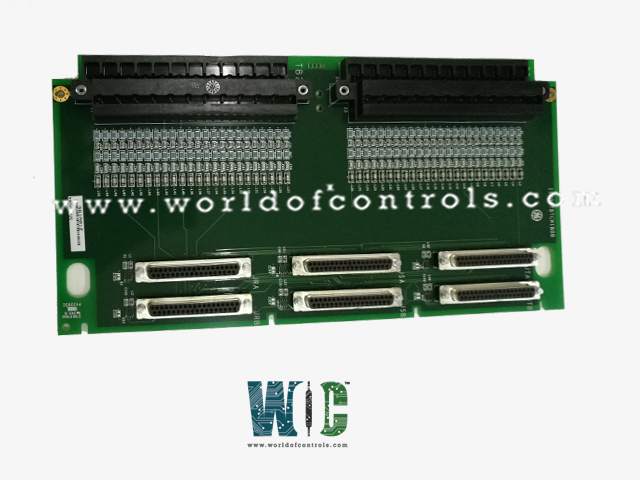
World Of Controls understands the criticality of your requirement and works towards reducing the lead time as much as possible.
IS230TBTCH4B - Simplex Thermocouple Input Assembly Module is available in stock which ships the same day.
IS230TBTCH4B - Simplex Thermocouple Input Assembly Module comes in UNUSED as well as REBUILT condition.
To avail our best deals for IS230TBTCH4B - Simplex Thermocouple Input Assembly Module, contact us and we will get back to you within 24 hours.
SPECIFICATIONS:
Part Number: IS230TBTCH4B
Manufacturer: General Electric
Series: Mark VIe
Product Type: Simplex Thermocouple Input Assembly Module
Number of Channels: 24
Thermocouple Types: E, J, K, S, T
Span: -8 mV to +45 mV
Technology: Surface mount
Operating temperature: -30 to 65°C
Size: 33.02 cm high x 10.16 cm
Repair: 3-7 days
Availability: In Stock
Country of Origin: United States
Manual: GEH-6721D
FUNCTIONAL DESCRIPTION:
IS230TBTCH4B is a Simplex Thermocouple Input Assembly Module manufactured and designed by General Electric as part of the Mark VIe Series used in GE Distributed Turbine Control Systems. The Thermocouple Terminal Board (TBTC) is designed to accommodate up to 24 thermocouple inputs, supporting multiple thermocouple types including Type E, J, K, S, and T. These thermocouple inputs are essential for accurate temperature measurement across a variety of industrial applications. The inputs are securely connected to the board using two robust barrier-type terminal blocks, which provide reliable and organized wiring for easy installation and maintenance.
Each thermocouple input is carefully isolated to ensure signal integrity and minimize interference, contributing to precise and consistent temperature readings. The TBTC board interfaces directly with the system’s I/O processor through DC-type connectors, enabling efficient data transmission and seamless integration within the control system. This setup ensures high-speed communication between the thermocouple sensors and the control unit, allowing real-time monitoring and control in critical processes such as turbine control, manufacturing, or energy management systems. In the Mark VIe system, the PTCC I/O pack works with the TBTC board. Simplex, dual, and TMR systems are supported. In simplex systems, two PTCC packs plug into the TBTCH1C for a total of 24 inputs. With the TBTCH1B one, two, or three PTCC packs plug-in supporting a variety of system configurations, but only 12 inputs are available. There are two types of terminal boards as follows:
INSTALLATION:
Thermocouples are wired directly to two removable I/O terminal blocks mounted securely on the TBTC (Thermocouple Terminal Board). These terminal blocks are designed for durability and ease of maintenance, being fastened firmly to the board using two screws each. The blocks are engineered to handle industrial-grade wiring, with each providing 24 terminals that can accept wires up to #12 AWG in size, allowing for secure and reliable electrical connections. This design facilitates quick installation and simplifies field wiring during commissioning or service procedures.
To ensure proper grounding and minimize electrical noise or signal interference, a dedicated shield terminal strip is provided on the left side of each terminal block. This strip is directly connected to the chassis ground and is used for terminating the shields of the thermocouple cables, helping to maintain signal integrity in environments with high electrical noise or potential ground loops.
The TBTC board is integrated with I/O packs that plug directly into the board via J-type connectors. These I/O packs serve as the interface between the thermocouple signals and the system's I/O network, converting analog temperature data into digital signals for processing by the control system. The number of I/O packs or connecting cables required varies depending on the system’s architecture and the level of redundancy specified. For high-reliability applications, redundant I/O configurations can be implemented, providing increased fault tolerance and improved system availability.
OPERATION:
The TBTC terminal board supports up to 24 thermocouple inputs, which can be either grounded or ungrounded, providing flexibility for a wide range of industrial temperature sensing applications. These thermocouples can be installed at distances of up to 300 meters (984 feet) from the turbine control panel, provided that the total two-way cable resistance does not exceed 450 ohms. This allows for remote monitoring in large-scale installations without compromising signal integrity.
To ensure accurate and stable temperature readings, the TBTC includes built-in high-frequency noise suppression components that help filter out electrical interference common in industrial environments. Additionally, the board is equipped with two integrated cold junction compensation (CJC) reference devices, which provide temperature references necessary for precise thermocouple measurement. These features contribute to high signal fidelity and enhanced measurement accuracy.
Analog-to-digital (A/D) conversion is performed in the I/O processor, not on the terminal board itself. The processor is also responsible for applying the appropriate linearization algorithms tailored to each thermocouple type (E, J, K, S, or T), ensuring that the raw thermoelectric voltage is accurately converted into meaningful temperature values.
WOC has the largest stock of Replacement parts for GE Distributed Turbine Control Systems. We can also repair your faulty boards and supply unused and rebuilt boards backed up with a warranty. Our team of experts is available around the clock to support your OEM needs. Our team of experts at WOC is happy to assist you with any of your automation requirements. For pricing and availability on parts and repairs, kindly contact our team by phone or email.
What is a Simplex Thermocouple Input Assembly Module?
A Simplex Thermocouple Input Assembly Module is a device used to read temperature signals from a single thermocouple sensor and convert them into digital data for industrial control systems.
What type of thermocouples does it support?
Most Simplex Thermocouple Input Modules support standard thermocouple types such as Type J, K, T, E, R, S, and B. However, the specific supported types depend on the module model. Refer to the product datasheet for compatibility.
What is the typical input range for this module?
The input range depends on the thermocouple type, but typically covers a wide range from -200°C to +1800°C. Always verify specific ranges based on thermocouple type and module model.